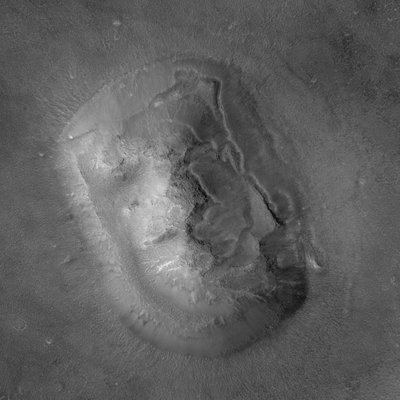

MGS MOC Release No. MOC2-283, 24 May 2001
1976 Viking view 2001 MGS view |
 | 50% Size (1.3 MBytes) | Full Size (5.4 MBytes) | | Unprocessed Full Image, E03-00824 (10.4 MBytes) | |
 Stereo with M16-00184 | Full Size (1.5 MBytes) | |
Viking orbiter images acquired in 1976 showed that one of thousands of buttes, mesas, ridges, and knobs in the transition zone between the cratered uplands of western Arabia Terra and the low, northern plains of Mars looked somewhat like a human face. The feature was subsequently popularized as a potential "alien artifact" in books, tabloids, radio talk shows, television, and even a major motion picture. Given the popularity of this landform, a new high-resolution view was targeted by pointing the spacecraft off-nadir on April 8, 2001. On that date at 20:54 UTC (8:54 p.m., Greenwich time zone), the MGS was rolled 24.8° to the left so that it was looking at the "face" 165 km to the side from a distance of about 450 km. The resulting image has a resolution of about 2 meters (6.6 feet) per pixel. If present on Mars, objects the size of typical passenger jet airplanes would be distinguishable in an image of this scale. An earlier picture obtained in June 2000 was combined with the new, April 2001 image, to produce a stereo ("3-D") view of the western portion of the hill ("3-D" glasses with red for left eye and blue for right eye are needed to view the anaglyph). The large "face" picture, above, covers an area about 3.6 kilometers (2.2 miles) on a side; the 3-D picture is about 1 km (0.62 mi) wide. Sunlight illuminates the images from the left/lower left.
Images Credit: NASA/JPL/Malin Space Science Systems
Previous, related releases:
Malin Space Science Systems and the California Institute of Technology built the MOC using spare hardware from the Mars Observer mission. MSSS operates the camera from its facilities in San Diego, CA. The Jet Propulsion Laboratory's Mars Surveyor Operations Project operates the Mars Global Surveyor spacecraft with its industrial partner, Lockheed Martin Astronautics, from facilities in Pasadena, CA and Denver, CO.